Heritage Trail location 3
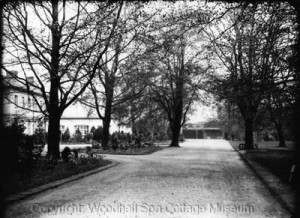
Photo 1 – This early photograph, taken from Coronation Road, shows the main entrance to the hotel to the left of the photograph. The Spa Baths can be seen in the rear, right of the photograph. (Photo courtesy of Woodhall Spa Cottage Museum).
In the 1830s, Mr Thomas Hotchkin, Lord of the Manor of Woodhall Spa, had a bath house built over a spring of water which many people, including himself, found beneficial to health.
Visiting a spa was a fashionable pursuit at this time and as people heard of this new spring and came to sample it, Mr Hotchkin set about the construction of a hotel in which to accommodate them.
This hostelry was completed in 1839 and 12 months later a group of medical men of the area, plus local gentry, met at “The New Hotel” to celebrate the opening of the Spa. Interestingly, this was before the water had been analysed.
In his book “Spas of England”, published in 1841, Dr Granville M. D. F. R. S describes how he advised Mr Hotchkin on the advisability of “procuring a perfect and correct knowledge of the chemical composition of the water”. He describes the hotel as a “neat, unostentatious edifice, honoured with the name of Victoria” (Queen Victoria had ascended to the throne in 1837).
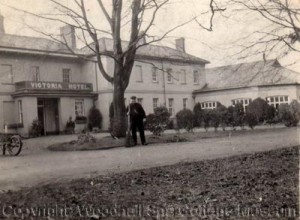
Photo 2 – The main entrance to the Victoria Hotel, taken in the early 1900s. The gardener is standing on what is now Coronation Road. The area behind the gardener is now woodland (The “Ups and Downs”). (Photo courtesy of Woodhall Spa Cottage Museum).
The two principal fronts faced South and West and there were two rows of stables separated by a large courtyard. Inside there was a dining room, morning room and drawing room, single as well as double bedrooms, the best of which had a favourable aspect, overlooking a fir plantation, or giving extended views towards Horncastle, or Tattershall Castle. The furniture was new and of the best kind and the Manageress was “active and mistress of her business, with an imposing figure and intelligent countenance.” The “spirited proprietor was determined to spare no expense to render this Spa deserving of the countenance of the better classes of society.” Sadly, the worthy doctor did not feel these “better classes” were aware of this Spa yet, for judging by the names and handwriting in the register, he deemed the majority of visitors were “farmers or people of the industrial classes.” The terms of the hotel were not considered extravagant. Single board for a day was 5 shillings, with 1 shilling more for a bedroom. Board and lodging for a servant was 3 shillings. A private sitting room cost 6 shillings a day.
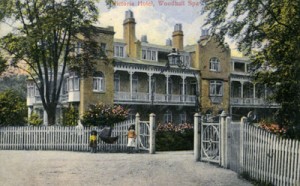
Photo 3 - Victoria Hotel - early 20th Century (Postcard from Webmaster's collection).
The Spa proved popular and when Mr T. J. S. (Stafford) Hotchkin succeeded his father as local Squire, in 1849, he set about replacing the building erected by his father with a large commodious hotel set in grounds of 100 acres. This proved a wise decision, for when the railway reached the Spa, in 1855, numbers of visitors requiring accommodation increased considerably. (Figs 1, 2, 3 & 4)
The Spa Baths and the Victoria Hotel were leased to Dr Robert Cuffe, M. R. C. S. for no less than 21 years, from 1862 until 1883. After he retired, the hotel was refurbished under the management of Mr A. J. Heaton. A bill of 1885 gives the total price of a visit lasting from luncheon on 15 May, until after breakfast on the 21st, as £9 – 13 – 6d.
However, Squire Hotchkin decided to sell the hotel and 70 acres of land, although the enterprise was still a flourishing concern. Mr. W. Colburn became Manager in January, 1886 and in April there was an advertisement for a cook who must “understand” soups, entrees and jellies. There had evidently been much discussion about the proposed sale because a Syndicate of several worthy gentlemen was formed to purchase the concern. On the 3rd July, the transaction was completed and on 31st of that month it was reported that the hotel was full to overflowing and ladies and gentlemen of title, as well as admirals and generals, desiring of staying at the Victoria, had to be turned away and were obliged to return to London.
There was an enthusiastic article in the Horncastle News on 21st August of that year. The reporter was effusive in his praise of the establishment. The grounds, he said, “are of a most extensive and pleasant description” and “adjoining the well kept gardens are capital cricket, croquet and lawn tennis grounds. The stabling arrangements are excellent and there are plenty of lockup coach houses. As far as outdoor advantages are concerned, the Victoria Hotel is simply perfection.” One begins to wonder if the indoor arrangements were not but no, there is gratifying praise for the interior of the hotel, also. Under the management of Mr. Charles Hawkins and his wife (who is “without a superior as a manageress”), it is described as “one of the best appointed and best managed establishments of its kind in the kingdom”, its only drawback being that it is not half big enough to accommodate the ever increasing number of would be guests. The drawing room is described as “a grand apartment, elegantly furnished.” And with its spacious dining room, “capital” smoking room, ladies room, sitting room, good billiard room and bedrooms “calculated to give satisfaction to the most fastidious of visitors,” it possessed all the attributes of a high class hotel. At the rear of the hotel was a restaurant and here again the reporter waxed enthusiastic, commenting that diners are served with the “excellence and rapidity of the Criterion and other great metropolitan restaurants.”
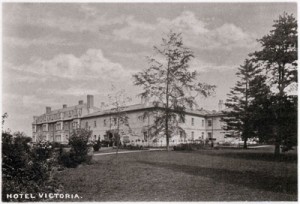
Photo 4 – The rear of the Victoria Hotel, after extension, taken from the extensive hotel grounds. The area is now woodlands. (Postcard from webmaster's collection).
However, Mr. and Mrs. Hawkins did not last long, for in April 1887 it was announced that the hotel had been let “for a term of years” to Mr. John Roberts, Proprietor of St. James Hall, Piccadilly and other esteemed establishments. The entire hotel of 150 rooms was to be reorganised.
The spacious grounds were utilised for garden parties and bazaars such as one held in June 1887, which was in aid of the Kirkstead Methodist Chapel and was opened by the mayor of Lincoln.
Sadly, in June of that year the death occurred of Mr Heaton who had been Manager of the hotel just two or three years previously.
At the beginning of the following year, the hotel had been “entirely remodelled and beautifully refurbished throughout”. The garden was surrounded by a park of 70 acres.
It was decided to have a special inaugural day to celebrate the work of the Syndicate and many important personages were invited. A special train conveyed visitors from London, among who were Lord Colville, Chairman of the Great Northern Railway, and Directors and the General Manager of that Company. There were titled people, ecclesiastical dignitaries, including the Bishop of Nottingham, eminent doctors from far and near and Major Davis, architect of the baths at Bath, under whose direction the remodelling of the Baths here had been effected by the Syndicate. The Mayor of Lincoln was present and, naturally, the gentlemen of the Syndicate, no doubt anxious for the guests’ approval of the alternatives. They were:- Rt. Hon. Edward Stanhope, M.P. for Horncastle and Secretary of State for War; Rt. Hon. Henry Chaplin M.P.; Sir Richard Webster, Attorney General; T Cheney Garfit Esq. and Rev J. O. Stephens. A triumphal arch of evergreens, flowers, and shields, had been erected at the entrance to the Hotel grounds, surmounted by the words “Success to Woodhall Spa”. The guests enjoyed a sumptuous luncheon, in a specially erected marquee, which was followed by toasts and speeches. They were shown around the entire complex and were “loud in their praises thereof”. The new South wing of the hotel, which had 17 bedrooms with private sitting rooms, was considered to be an elegant and tasteful addition, as well as considerably increasing the accommodation available.
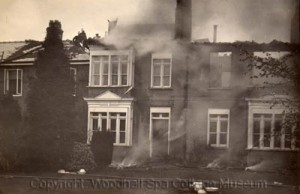
Photo 5 – Firemen on the roof of the Victoria Hotel damping down after the fire on Easter Sunday 1920. (Photo courtesy of Woodhall Spa Cottage Museum).
The Syndicate did not rest on its laurels for less than a year later it was reported that a magnificent dining room seating 160 people and with a minstrels’ gallery for balls and soirées had been built. The chef of the Victoria, Monsieur A. Kruz, was evidently top notch, for he won a bronze medal for “artistic cookery”, with his creation of “aspic de foie gras aux truffles”, at a cookery exhibition in London, in May 1889.
The Victoria Hotel was the obvious choice for the celebratory luncheon, again attended by the great and the good, at the opening of the Alexandra Hospital, in May 1890. The gathering was served consommé, salads (one of lobster), quail pie, pigeon pie, galantine of chicken truffe, forequarter of lamb, fore rib of beef, boar’s head, York ham etc., with an array of desserts, including strawberries, cheesecakes and Charlotte a la Vanille.
In June, Mr Roberts “carried the respect and good wishes of everybody” when he relinquished his post as Manager of the Hotel. He was succeeded by Mr. Paine, who brought with him “the fashionable atmosphere of Brighton”.
By August, the hotel was reported as being absolutely full with not so much as an attic room unoccupied. The billiard room had been improved and the table was “one of the best in the country”. The following week, the fashionable Mr. Paine introduced music in the dining room. The minstrels’ gallery was prettily decorated and the Spa band, stationed there, played during the course of the meal. However, perhaps the gentleman from Brighton proved too fashionable for Lincolnshire taste for he was replaced by Mr. and Mrs. Hunt at the end of May 1890, having been here less than a year.
In Edwardian times, it cost 12/- a day for a room on the ground floor and 13/6 for the first floor, except during the high season, mid July to mid September, when it was more expensive. Rooms for servants cost 2/- and 5/-. A fire in a bedroom was 2/- extra, but only 1/- if it was required for the morning alone. Hip baths in bedrooms were 6d, dinner (including coffee was 5/- and as Woodhall Spa became noted for golf, after the opening of Mr Hotchkin’s Golf Links, in 1905, there was a Golfers’ Special Weekend. This consisted of 1st class rail, return from King’s Cross, all meals from Friday lunch to Monday breakfast, and the golf fee. It cost a staggering £2.15.
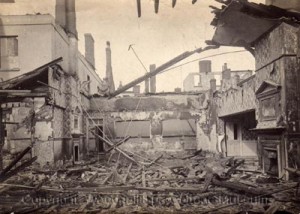
Photo 6 – Part of the gutted interior of the Victoria Hotel after the fire on Easter Sunday 1920. (Photo courtesy of Woodhall Spa Cottage Museum).
After the dark days of World War 1, it was hoped that the Woodhall Spa baths and the Victoria Hotel would draw crowds of visitors as before. Alas, disaster struck less than 2 years after the war had ended. At this time, the hotel had a turnover of £25,000 a year. In the spring of 1920, the building had just been redecorated for the start of the Season when, early in the morning of Easter Sunday 4th April, an electrical fault started a fire in the boiler room, which spread to the linen room above. The wife of the porter, James Rose, smelled burning at 3.30 a.m. The Manager, Capt. Farmer, aroused the staff and guests, who were evacuated from the hotel, although some helped to remove furniture to the lawns outside. Woodhall Spa and Horncastle Fire Brigades were called out, but the fire was burning furiously by the time they arrived. The fire fighters were handicapped by lack of water as the hydrant was on the Broadway and was only enough for one jet. Later, an elderly resident who remembered the fire, recalled water being obtained from the stream that runs behind the Teahouse. Another said that the local Brigade had worried that the hotel was a fire risk. “Mt father was Captain of the Fire Brigade and he thought there should have been a lake in the grounds - they had just about everything else!” Residents awoke to see flames high above the trees and made their way to the hotel to see if they could help. The fire brigade from Lincoln set off to lend assistance but the rear axle of the brand new motor engine broke 10 miles away. To the horror and dismay of the people of Woodhall Spa, their prestigious and beautiful hotel was gutted. It was the end of an era. (Figs 5 and 6)
The hotel was never rebuilt and the area has reverted to woodland. Vegetation has grown over the foundations, causing lines of small hillocks; giving the area the local name of “The Ups and Downs”. Many of the exotic and specimen trees planted in the hotel gardens can still be seen mixed in with the native trees.
Heritage Trail locations
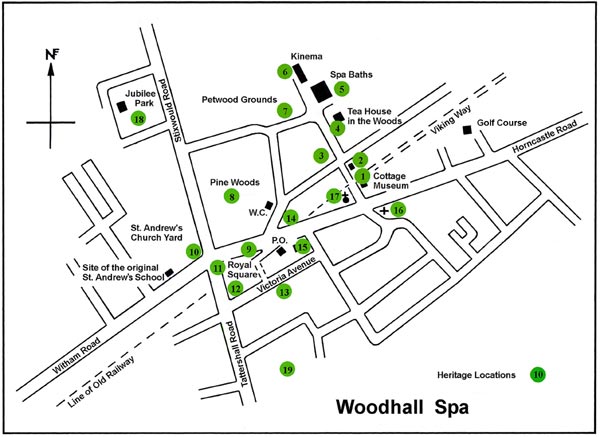
The trail can be started at any location, but we suggest you also visit the Cottage Museum to see the photographs taken by John Wield during the heyday of the Spa and items associated with this unique Victorian Spa town.
The Trail is just one of several projects in the hands of the Woodhall Spa Parish Council sponsored Heritage Committee. Click here if you are interested in the committee or their projects.
How well do you know Woodhall Spa?
See if you can identify the location of these architectural features and items of street furniture! Or find the Letterbox (coming soon).
Find out more about the Woodhall Spa Conservation Area